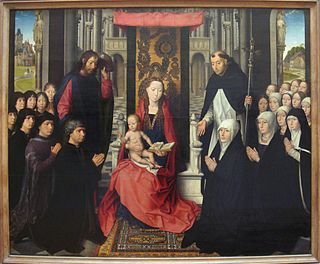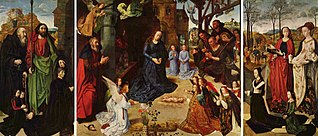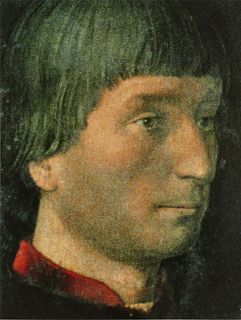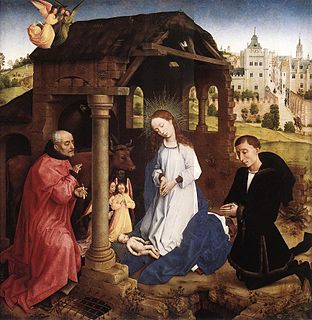Description
The scenes of the Passion start in the distance at the top left with Jesus's entry into Jerusalem on Palm Sunday, passes through the town and out again to the bottom left to the Garden of Gethsemane, through the Passion scenes in the centre of the city (judgment of Pilate, the Flagellation of Jesus, Crowning with Thorns, Ecce Homo), then follows the procession of the cross back out of the city to the bottom right, then up to the top for the crucifixion, and ending in the distance at the top right with the appearances at Emmaus and Galilee. It includes seven of the traditional 14 Stations of the Cross, but adds several scenes before and after them, and omits 7: Jesus being given his cross, two occasions when Jesus falls carrying the cross, Jesus meeting his mother, Veronica wiping the face of Jesus, Jesus meeting the daughters of Jerusalem, and Jesus being stripped of his garments.
The scenes are distributed in and around an idealized Jerusalem, depicted as a walled medieval city with exotic towers topped by domes. The high "birds-eye" point of view makes Calvary visible behind the city. Unusually, for paintings of this period, the lighting across the painting is internal, associated with the rising sun on the far right, and consistent across the painting, with areas to the rear right in the light and areas to the front left in shadow.
The chronology
In order, the scenes are:
| 1. | Jesus rides into the city on a donkey on Palm Sunday | top left, outside the city gatehouse |
| 2. | Jesus driving the money-changers out of the Temple | to the right of the entry of Jesus, under a double arch |
| 3. | Judas betrays Jesus to the High Priests | down and to the left from the temple scene, in a narrow candle-lit archway |
| 4. | The Last Supper | to the left of the betrayal, in a building with a pitched roof |
| 5. | Prayer in the Garden of Gethsemane | below the Last Supper; three apostles lie sleeping while Jesus prays |
| 6. | Arrest of Christ | down and right from the garden: Judas kisses Jesus; Peter cuts off Malchus' ear |
| 7. | Denial of Peter | above and right from the arrest: Peter shown in a doorway, with cock crowing above |
| 8. | Christ before Pilate | left of centre; Pilate seated on his throne (traditional Station of the Cross no.1) |
| 9. | Flagellation of Christ | centre |
| 10. | Second interrogation by Pilate | right of centre, skipping across two scenes in a narrow building set back |
| 11. | Crowning with Thorns | right of the flagellation, Jesus receives a crown with thorns and a purple robe |
| 12. | Ecce Homo | right from the crowning with thorns: Christ is shown to the people, who condemn him to death |
| 13. | Making of the Cross | down and left, below the flagellation |
| 14. | Carrying of the Cross; Simon of Cyrene bears the cross | below and proceeding to the right, a procession leaves from the city gate; on the road outside, Christ falls to his knees, and is assisted by Simon of Cyrene (traditional Stations of the Cross nos 3 and 5) |
| 15. | Jesus is nailed to the cross | top, right of centre (traditional Station of the Cross no.11) |
| 16. | Crucifixion | above, to the left, Jesus dies on Golgotha, together with two criminals (traditional Station of the Cross no.12) |
| 17. | Descent from the Cross | to the right, Christ is removed from the cross at night (traditional Station of the Cross no.13) |
| 18. | The Entombment | below the descent from the cross, to the right (traditional Station of the Cross no.14) |
| 19. | Christ in Limbo | to the right of the procession, Christ with a crucifix |
| 20. | Resurrection | above limbo, with the guards asleep |
| 21. | Meeting with Mary Magdalene: noli me tangere | above the resurrection |
| 22. | On the Road to Emmaus | top right |
| 23. | Appearance before the apostles at the Sea of Galilee | to the left of the meeting with Mary Magdalene |

Lorenzo Ghiberti, born Lorenzo di Bartolo, was an Italian Renaissance sculptor from Florence, a key figure in the Early Renaissance, best known as the creator of two sets of bronze doors of the Florence Baptistery, the later one called by Michelangelo the Gates of Paradise. Trained as a goldsmith and sculptor, he established an important workshop for sculpture in metal. His book of Commentarii contains important writing on art, as well as what may be the earliest surviving autobiography by any artist.

Hans Memling was a painter active in Flanders, who worked in the tradition of Early Netherlandish painting. He was born in the Middle Rhine region and probably spent his childhood in Mainz. He moved to the Netherlands and spent time in the Brussels workshop of Rogier van der Weyden. He was subsequently made a citizen of Bruges in 1465, where he became one of the leading artists, running a large workshop, which painted religious works that often incorporated donor portraits of his wealthy patrons. Memling's patrons included burghers, clergymen, and aristocrats.

Pietro Lorenzetti or Pietro Laurati was an Italian painter, active between c.1306 and 1345. Together with his younger brother Ambrogio, he introduced naturalism into Sienese art. In their artistry and experiments with three-dimensional and spatial arrangements, the brothers foreshadowed the art of the Renaissance.

The Collegiata di Santa Maria Assunta or Duomo di San Gimignano is a Roman Catholic collegiate church and minor basilica in San Gimignano, in Tuscany in central Italy. It contains important cycles of Renaissance frescoes by artists including Domenico Ghirlandaio, Benozzo Gozzoli, Taddeo di Bartolo, Lippo Memmi and Bartolo di Fredi. It falls within the UNESCO World Heritage Site of the "Historic Centre of San Gimignano", with its frescoes being described by UNESCO as "works of outstanding beauty".

Hugo van der Goes was one of the most significant and original Flemish painters of the late 15th century. Van der Goes was an important painter of altarpieces as well as portraits. He introduced important innovations in painting through his monumental style, use of a specific colour range and individualistic manner of portraiture. From 1483 onwards, the presence of his masterpiece, the Portinari Triptych, in Florence played a role in the development of realism and the use of colour in Italian Renaissance art.

The Portinari Altarpiece or Portinari Triptych is an oil on wood triptych painting by the Flemish painter Hugo van der Goes, commissioned by Tommaso Portinari, representing the Adoration of the Shepherds. It measures 253 x 304 cm, and is now in the Galleria degli Uffizi in Florence, Italy. This altarpiece is filled with figures and religious symbols. Of all the late fifteenth century Flemish artworks, this painting is said to be the most studied.

The Last Judgment is a triptych attributed to Flemish painter Hans Memling and painted between 1467 and 1471. It is now in the National Museum in Gdańsk in Poland. It was commissioned by Angelo Tani, an agent of the Medici at Bruges, but was captured at sea by Paul Beneke, a privateer from Danzig. A lengthy lawsuit against the Hanseatic League demanded its return to Italy. It was placed in the Basilica of the Assumption but in the 20th century it was moved to its present location.

Tommaso Portinari was an Italian banker for the Medici bank in Bruges. He was a member of a prominent Florentine family, coming from Portico di Romagna, near Forlì; that family had included Dante's muse, Beatrice Portinari. His father was a Medici branch manager, and after his death in 1421, Tommaso and his orphaned brothers were taken in and raised in the household of Cosimo de Medici. Today he is mainly remembered for two significant commissions of Early Netherlandish paintings.

Christ Carrying the Cross on his way to his crucifixion is an episode included in the Gospel of John, and a very common subject in art, especially in the fourteen Stations of the Cross, sets of which are now found in almost all Roman Catholic churches, as well as in many Lutheran churches and Anglican churches. However, the subject occurs in many other contexts, including single works and cycles of the Life of Christ or the Passion of Christ. Alternative names include the Procession to Calvary, Road to Calvary and Way to Calvary, Calvary or Golgotha being the site of the crucifixion outside Jerusalem. The actual route taken is defined by tradition as the Via Dolorosa in Jerusalem, although the specific path of this route has varied over the centuries and continues to be the subject of debate.

The circumcision of Jesus is an event from the life of Jesus, according to the Gospel of Luke chapter 2, which states:
And when eight days were fulfilled to circumcise the child, his name was called Jesus, the name called by the angel before he was conceived in the womb.

The Life of Christ as a narrative cycle in Christian art comprises a number of different subjects narrating the events from the life of Jesus on Earth. They are distinguished from the many other subjects in art showing the eternal life of Christ, such as Christ in Majesty, and also many types of portrait or devotional subjects without a narrative element.

A donor portrait or votive portrait is a portrait in a larger painting or other work showing the person who commissioned and paid for the image, or a member of his, or her, family. Donor portrait usually refers to the portrait or portraits of donors alone, as a section of a larger work, whereas votive portrait may often refer to a whole work of art intended as an ex-voto, including for example a Madonna, especially if the donor is very prominent. The terms are not used very consistently by art historians, as Angela Marisol Roberts points out, and may also be used for smaller religious subjects that were probably made to be retained by the commissioner rather than donated to a church.

The Resurrection of Jesus has long been central to Christian faith and Christian art, whether as a single scene or as part of a cycle of the Life of Christ. In the teachings of the traditional Christian churches, the sacraments derive their saving power from the passion and resurrection of Christ, upon which the salvation of the world entirely depends. The redemptive value of the resurrection has been expressed through Christian art, as well as being expressed in theological writings.

Advent and Triumph of Christ is an oil painting on a panel of wood, painted c.1480 by German-born Early Netherlandish painter Hans Memling. It was made for the altar of the Tanners' guild in Our Lady's Church in Bruges, but is now held by the Alte Pinakothek in Munich.

The Crucifixion and Last Judgement diptych consists of two small painted panels attributed to the Early Netherlandish artist Jan van Eyck, with areas finished by unidentified followers or members of his workshop. This diptych is one of the early Northern Renaissance oil on panel masterpieces, renowned for its unusually complex and highly detailed iconography, and for the technical skill evident in its completion. It was executed in a miniature format; the panels are just 56.5 cm (22.2 in) high by 19.7 cm (7.8 in) wide. The diptych was probably commissioned for private devotion.

The Annunciation is an oil painting on oak panel attributed to Early Netherlandish painter Hans Memling. It depicts the Annunciation, the archangel Gabriel's announcement to the Virgin Mary that she would conceive and become the mother of Jesus, described in the Gospel of Luke. The painting was completed c. 1482 and was partially transferred to canvas in the 1920s; it is today held in the Robert Lehman collection of the Metropolitan Museum of Art in New York.

Portrait of Maria Portinari is a small c. 1470–72 painting by Hans Memling in tempera and oil on oak panel. It portrays Maria Maddalena Baroncelli, about whom very little is known. She is about 14 years old, and depicted shortly before her wedding to the Italian banker, Tommaso Portinari. Maria is dressed in the height of late fifteenth-century fashion, with a long black hennin with a transparent veil and an elaborate jewel-studded necklace. Her headdress is similar and a necklace identical to those in her depiction in Hugo van der Goes's later Portinari Altarpiece, a painting that may have been partly based on Memling's portrait.

The Diptych of Maarten van Nieuwenhove is a 1487 painting by Hans Memling, showing on the left side the Virgin and Child, and on the right side Maarten van Nieuwenhove. It is now kept in the Old St. John's Hospital in Bruges. It is unsigned, but has invariably been attributed to Hans Memling since the middle of the 19th century.

Portrait of Tommaso Portinari by Hans Memling is held by the Metropolitan Museum of Art, New York City. It was made c.1470 in oil on oak panel, and measures 44.1 by 33.7 centimetres. The painting and Memling's Portrait of Maria Portinari form the wings from a since dismantled triptych; the central panel is believed to have been a now lost depiction of the Madonna and Child; perhaps Memling's Virgin and Child in the National Gallery, London.

The Pagagnotti Triptych is an oil-on-wood triptych by Hans Memling produced circa 1480. The original was disassembled and separated, with the center panel held at the Uffizi gallery in Florence and the two wing panels at the National Gallery in London.






















